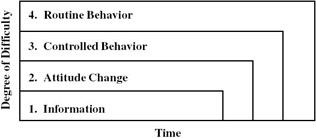Westside Toastmasters is located in Los Angeles and Santa Monica, California
TRANSFORMING LEADERSHIP LEARNING ACTIVITIES
Learning to be an inner leader engages the leader in specific behaviors. The following may be useful to both leaders and to leader trainers to gain experience and familiarity in learning how to change others.
Activity 1: The Group Change Process (from Kirt Lewin, 1994)
Instructions. The traditional model of change can be traced to the work of Kirt Lewin. Working in the 1930s, Lewin and his students developed a generic change model suitable to explain change and predict participant behavior in most interpersonal situations. An expanded model of this change process includes the following steps:
Contemporary Model for the Leadership of Change
-
Identify Forces for Change
-
Recognition of the Need for Change
-
Diagnosis of the Problem
-
Identification of Alternative Methods
-
Recognition of Limiting Conditions
-
Selection of One Method
-
Implementation of Program
-
Evaluation of Program
-
Think of a significant change you experienced in the past six months or year.
-
Describe that change using the Lewin model.
-
Analyze that change using the change model by responding to the following questions:
Was the change successful?
Did followers in the client system accept the change? Were they enthusiastic? Or not?
What steps were left out?
What steps did they emphasize?
Did the change agents do anything overt to show that they responded to this important part of change management?
What specific behavior or actions did they make?
Was the client community—the followers asked to change—aware of this step? That is, did the change agents make the reasons for their actions clear to followers?
How would you have improved on the tasks of leading this change event?
List the things you have learned about change that you want to apply to your next change situation.
Activity 2: Change Management
Instructions. Technological developments, restructuring, reorganizations, downsizing, or changes in company policies, procedures, or philosophies all place pressures on work communities to change to stay dynamic. Inner leaders—all professionals—have to face and accept these changes. They must also aid in the change process and help others feel comfortable with the adaptions they need to make. All change resolves itself into a process of changing people—their values, attitudes, knowledge and behaviors. One way to lead people change is to use the following model. The process includes four steps.
-
Write a short personal case study describing a recent change in your recent work experience.
-
Couch your description in terms of the people change model shown in Figure 7.1.
-
Assess your success. How did adherence to this model (even though it might have been blind adherence) affect success?
-
How can you relate any less-than-successful results to failure to effectively follow this model?




